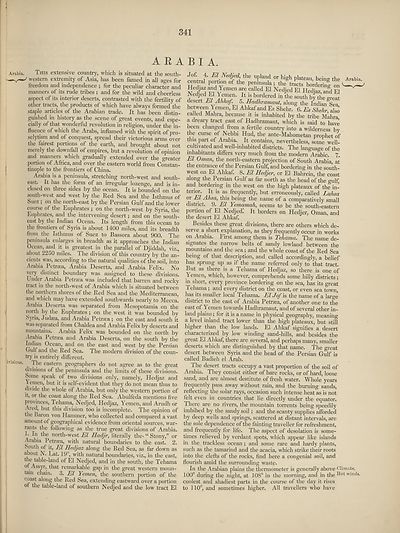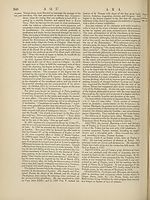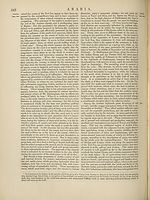Encyclopaedia Britannica > Volume 3, Anatomy-Astronomy
(349) Page 341 - Arabia
Download files
Complete book:
Individual page:
Thumbnail gallery: Grid view | List view

341
ARABIA.
Arabia.
ivistons.
This extensive country, which is situated at the south¬
western extremity of Asia, has been famed in all ages for
freedom and independence ; for the peculiar character and
manners of its rude tribes ; and for the wild and cheerless
aspect of its interior deserts, contrasted with the fertility of
other tracts, the products of which have always formed the
staple articles of the Arabian trade. It has been distin¬
guished in history as the scene of great events, and espe¬
cially of that wonderful revolution in religion, under the in¬
fluence of which the Arabs, inflamed with the spirit of pro-
selytism and of conquest, spread their victorious arms over
the fairest portions of the earth, and brought about not
merely the downfall of empires, but a revolution of opinion
and manners which gradually extended over the greater
portion of Africa, and over the eastern world from Constan¬
tinople to the frontiers of China.
Arabia is a peninsula, stretching north-west and south¬
east. It has the form of an irregular lozenge, and is in¬
closed on three sides by the ocean. It is bounded on the
south-west and west by the Red Sea and the Isthmus of
Suez ; on the north-east by the Persian Gulf and the lower
course of the Euphrates ; on the north-west by Syria, the
Euphrates, and the intervening desert; and on the south¬
east by the Indian Ocean. Its length from this ocean to
the frontiers of Syria is about 1400 miles, and its breadth
from the Isthmus of Suez to Bassora about 900. The
peninsula enlarges in breadth as it approaches the Indian
Ocean, and it is greatest in the parallel of Djiddah, viz.,
about 2250 miles. The division of this country by the an¬
cients was, according to the natural qualities of the soil, into
Arabia Petraea, Arabia Deserta, and Arabia Felix. No
very distinct boundary was assigned to these divisions.
Under Arabia Petraea was included that barren and rocky
tract in the north-west of Arabia which is situated between
the northern shores of the Red Sea and the Mediterranean,
and which may have extended southwards nearly to Mecca.
Arabia Deserta was separated from Mesopotamia on the
north by the Euphrates; on the west it was bounded by
Syria, Judaea, and Arabia Petraea; on the east and south it
was separated from Chaldea and Arabia Felix by deserts and
mountains. Arabia Felix was bounded on the north by
Arabia Petraea and Arabia Deserta, on the south by the
Indian Ocean, and on the east and west by the Persian
Gulf and the Red Sea. The modern division of the coun¬
try is entirely different.
The eastern geographers do not agree as to the great
divisions of the peninsula and the limits of these divisions.
Some speak of two divisions only, namely, Hedjaz and
Yemen, but it is self-evident that they do not mean thus to
divide the whole of Arabia, but only the western portion of
it, or the coast along the Red Sea. Abulfeda mentions five
provinces, Tehama, Nedjed, Hedjaz, Yemen, and Arudh or
Ared, but this division too is incomplete. The opinion of
the Baron von Hammer, who collected and compared a vast
amount of geographical evidence from oriental sources, war¬
rants the following as the true great divisions of Arabia.
1. In the north-west El Hadjr, literally the* “ Stony,” or
Arabia Petraea, with natural boundaries to the east. 2.
v’uth of it, El Hedjaz along the Red Sea, as far down as
about N. Lat. 19°, with natural boundaries, viz., in the east,
e table-land of El Nedjed, and in the south, the Tehama
o Assyr, that remarkable gap in the great western moun¬
tain chain. 3. El Yemen, the southern portion of the
coast along the Red Sea, extending eastward over a portion
of the table-land of southern Nedjed and the low tract El
Jof. 4. El Nedjed, the upland or high plateau beimr the Arabia
centri portion of the peninsula; ,hegtrLs borderinf on W-
Nert ed “A1 Jen,eD "f .caJled,E1 Nedjed El Hedjaz, and El
Nedjed El Yemen. It is bordered in the south by the great
desert El Ahkaf. 5. Hadhramaut, along the Indian^Sea
beitrrMYifmen’ E Ahkafand Es Shehr* 6-Es Shehr, also
called Mahra, because it is inhabited by the tribe Mahra
a dreary tract east of Hadhramaut, which is said to have
been changed from a fertile country into a wilderness bv
the curse of Nebbi Hud, the ante-Mahometan prophet of
this part of Arabia. It contains, nevertheless, some well-
cultivated and well-inhabited districts. The language of the
inhabitants differs very much from the modern Arabic. 7.
El Oman, the north-eastern projection of South Arabia, at
the entrance of the Persian Gulf, and bordering in the south¬
west on El Ahkaf. 8. El Hedjer, or El Bahrein, the coast
along the Persian Gulf as far north as the head of the o-ulf
and bordering in the west on the high plateaux of the in¬
terior. It is as frequently, but erroneously, called Lahsa
or El Ahsa, this being the name of a comparatively small
district. 9. El Yemamah, seems to be the south-eastern
portion of El Nedjed: It borders on Hedjer, Oman, and
the desert El Ahkaf.
Besides these great divisions, there are others which de¬
serve a short explanation, as they frequently occur in works
on Arabia. First among them is Tehama. The name de¬
signates the narrow belts of sandy lowland between the
mountains and the sea; and the whole coast of the Red Sea
being of that description, and called accordingly, a belief
has sprung up as if the name referred only to that tract.
But as there is a Tehama of Hedjaz, so there is one of
\ emen, which, however, comprehends some hilly districts ;
in short, every province bordering on the sea, has its great
Tehama; and every district on the coast, or even sea town,
has its smaller local Tehama. El Jof is the name of a large
district to the east of Arabia Petraea, of another one to the
east of Yemen towards Hadhramaut, and of several other in¬
land plains; for it is a name in physical geography, meaning
a level inland tract lower than the high plateaux, but still
higher than the low lands. El Ahkaf signifies a desert
characterized by low winding sand-hills, and besides the
great El Ahkaf, there are several, and perhaps many, smaller
deserts which are distinguished by that name. The great
desert between Syria and the head of the Persian Gulf is
called Badieh el Arab.
The desert tracts occupy a vast proportion of the soil of
Arabia. They consist either of bare rocks, or of hard, loose
sand, and are almost destitute of fresh water. Whole years
frequently pass away without rain, and the burning sands,
reflecting the solar rays, occasion such intense heat as is not
felt even in countries that lie directly under the equator.
There are no rivers, the mountain torrents being speedily
imbibed by the sandy soil; and the scanty supplies afforded
by deep wells and springs, scattered at distant intervals, are
the sole dependence of the fainting traveller for refreshment,
and frequently for life. The aspect of desolation is some¬
times relieved by verdant spots, which appear like islands
in the trackless ocean ; and some rare and hardy plants,
such as the tamarind and the acacia, which strike their roots
into the clefts of the rocks, find here a congenial soil, and
flourish amid the surrounding waste.
In the Arabian plains the thermometer is generally above Climate.
100° during the night, at 108° in the morning, and in the Hot winds,
coolest and shadiest parts in the course of the day it rises
to 110°, and sometimes higher. All travellers who have
ARABIA.
Arabia.
ivistons.
This extensive country, which is situated at the south¬
western extremity of Asia, has been famed in all ages for
freedom and independence ; for the peculiar character and
manners of its rude tribes ; and for the wild and cheerless
aspect of its interior deserts, contrasted with the fertility of
other tracts, the products of which have always formed the
staple articles of the Arabian trade. It has been distin¬
guished in history as the scene of great events, and espe¬
cially of that wonderful revolution in religion, under the in¬
fluence of which the Arabs, inflamed with the spirit of pro-
selytism and of conquest, spread their victorious arms over
the fairest portions of the earth, and brought about not
merely the downfall of empires, but a revolution of opinion
and manners which gradually extended over the greater
portion of Africa, and over the eastern world from Constan¬
tinople to the frontiers of China.
Arabia is a peninsula, stretching north-west and south¬
east. It has the form of an irregular lozenge, and is in¬
closed on three sides by the ocean. It is bounded on the
south-west and west by the Red Sea and the Isthmus of
Suez ; on the north-east by the Persian Gulf and the lower
course of the Euphrates ; on the north-west by Syria, the
Euphrates, and the intervening desert; and on the south¬
east by the Indian Ocean. Its length from this ocean to
the frontiers of Syria is about 1400 miles, and its breadth
from the Isthmus of Suez to Bassora about 900. The
peninsula enlarges in breadth as it approaches the Indian
Ocean, and it is greatest in the parallel of Djiddah, viz.,
about 2250 miles. The division of this country by the an¬
cients was, according to the natural qualities of the soil, into
Arabia Petraea, Arabia Deserta, and Arabia Felix. No
very distinct boundary was assigned to these divisions.
Under Arabia Petraea was included that barren and rocky
tract in the north-west of Arabia which is situated between
the northern shores of the Red Sea and the Mediterranean,
and which may have extended southwards nearly to Mecca.
Arabia Deserta was separated from Mesopotamia on the
north by the Euphrates; on the west it was bounded by
Syria, Judaea, and Arabia Petraea; on the east and south it
was separated from Chaldea and Arabia Felix by deserts and
mountains. Arabia Felix was bounded on the north by
Arabia Petraea and Arabia Deserta, on the south by the
Indian Ocean, and on the east and west by the Persian
Gulf and the Red Sea. The modern division of the coun¬
try is entirely different.
The eastern geographers do not agree as to the great
divisions of the peninsula and the limits of these divisions.
Some speak of two divisions only, namely, Hedjaz and
Yemen, but it is self-evident that they do not mean thus to
divide the whole of Arabia, but only the western portion of
it, or the coast along the Red Sea. Abulfeda mentions five
provinces, Tehama, Nedjed, Hedjaz, Yemen, and Arudh or
Ared, but this division too is incomplete. The opinion of
the Baron von Hammer, who collected and compared a vast
amount of geographical evidence from oriental sources, war¬
rants the following as the true great divisions of Arabia.
1. In the north-west El Hadjr, literally the* “ Stony,” or
Arabia Petraea, with natural boundaries to the east. 2.
v’uth of it, El Hedjaz along the Red Sea, as far down as
about N. Lat. 19°, with natural boundaries, viz., in the east,
e table-land of El Nedjed, and in the south, the Tehama
o Assyr, that remarkable gap in the great western moun¬
tain chain. 3. El Yemen, the southern portion of the
coast along the Red Sea, extending eastward over a portion
of the table-land of southern Nedjed and the low tract El
Jof. 4. El Nedjed, the upland or high plateau beimr the Arabia
centri portion of the peninsula; ,hegtrLs borderinf on W-
Nert ed “A1 Jen,eD "f .caJled,E1 Nedjed El Hedjaz, and El
Nedjed El Yemen. It is bordered in the south by the great
desert El Ahkaf. 5. Hadhramaut, along the Indian^Sea
beitrrMYifmen’ E Ahkafand Es Shehr* 6-Es Shehr, also
called Mahra, because it is inhabited by the tribe Mahra
a dreary tract east of Hadhramaut, which is said to have
been changed from a fertile country into a wilderness bv
the curse of Nebbi Hud, the ante-Mahometan prophet of
this part of Arabia. It contains, nevertheless, some well-
cultivated and well-inhabited districts. The language of the
inhabitants differs very much from the modern Arabic. 7.
El Oman, the north-eastern projection of South Arabia, at
the entrance of the Persian Gulf, and bordering in the south¬
west on El Ahkaf. 8. El Hedjer, or El Bahrein, the coast
along the Persian Gulf as far north as the head of the o-ulf
and bordering in the west on the high plateaux of the in¬
terior. It is as frequently, but erroneously, called Lahsa
or El Ahsa, this being the name of a comparatively small
district. 9. El Yemamah, seems to be the south-eastern
portion of El Nedjed: It borders on Hedjer, Oman, and
the desert El Ahkaf.
Besides these great divisions, there are others which de¬
serve a short explanation, as they frequently occur in works
on Arabia. First among them is Tehama. The name de¬
signates the narrow belts of sandy lowland between the
mountains and the sea; and the whole coast of the Red Sea
being of that description, and called accordingly, a belief
has sprung up as if the name referred only to that tract.
But as there is a Tehama of Hedjaz, so there is one of
\ emen, which, however, comprehends some hilly districts ;
in short, every province bordering on the sea, has its great
Tehama; and every district on the coast, or even sea town,
has its smaller local Tehama. El Jof is the name of a large
district to the east of Arabia Petraea, of another one to the
east of Yemen towards Hadhramaut, and of several other in¬
land plains; for it is a name in physical geography, meaning
a level inland tract lower than the high plateaux, but still
higher than the low lands. El Ahkaf signifies a desert
characterized by low winding sand-hills, and besides the
great El Ahkaf, there are several, and perhaps many, smaller
deserts which are distinguished by that name. The great
desert between Syria and the head of the Persian Gulf is
called Badieh el Arab.
The desert tracts occupy a vast proportion of the soil of
Arabia. They consist either of bare rocks, or of hard, loose
sand, and are almost destitute of fresh water. Whole years
frequently pass away without rain, and the burning sands,
reflecting the solar rays, occasion such intense heat as is not
felt even in countries that lie directly under the equator.
There are no rivers, the mountain torrents being speedily
imbibed by the sandy soil; and the scanty supplies afforded
by deep wells and springs, scattered at distant intervals, are
the sole dependence of the fainting traveller for refreshment,
and frequently for life. The aspect of desolation is some¬
times relieved by verdant spots, which appear like islands
in the trackless ocean ; and some rare and hardy plants,
such as the tamarind and the acacia, which strike their roots
into the clefts of the rocks, find here a congenial soil, and
flourish amid the surrounding waste.
In the Arabian plains the thermometer is generally above Climate.
100° during the night, at 108° in the morning, and in the Hot winds,
coolest and shadiest parts in the course of the day it rises
to 110°, and sometimes higher. All travellers who have
Set display mode to:
![]() Universal Viewer |
Universal Viewer | ![]() Mirador |
Large image | Transcription
Mirador |
Large image | Transcription
Images and transcriptions on this page, including medium image downloads, may be used under the Creative Commons Attribution 4.0 International Licence unless otherwise stated. ![]()
| Encyclopaedia Britannica > Encyclopaedia Britannica > Volume 3, Anatomy-Astronomy > (349) Page 341 - Arabia |
|---|
| Permanent URL | https://digital.nls.uk/193761885 |
|---|
| Attribution and copyright: |
|
|---|---|
| Shelfmark | EB.16 |
|---|---|
| Description | Ten editions of 'Encyclopaedia Britannica', issued from 1768-1903, in 231 volumes. Originally issued in 100 weekly parts (3 volumes) between 1768 and 1771 by publishers: Colin Macfarquhar and Andrew Bell (Edinburgh); editor: William Smellie: engraver: Andrew Bell. Expanded editions in the 19th century featured more volumes and contributions from leading experts in their fields. Managed and published in Edinburgh up to the 9th edition (25 volumes, from 1875-1889); the 10th edition (1902-1903) re-issued the 9th edition, with 11 supplementary volumes. |
|---|---|
| Additional NLS resources: |
|

